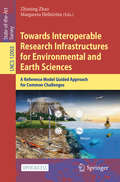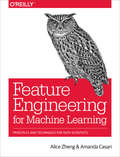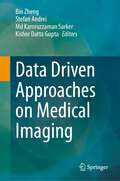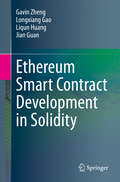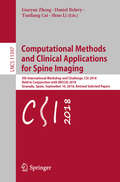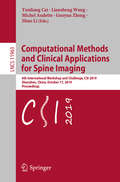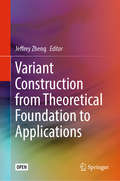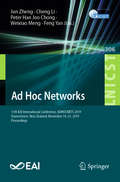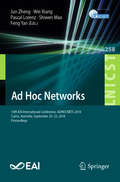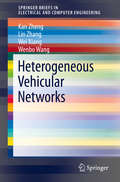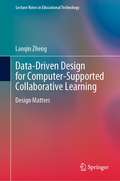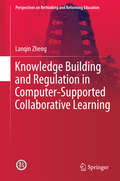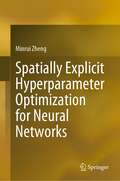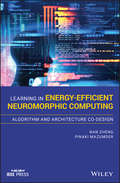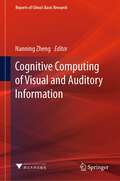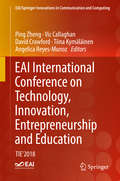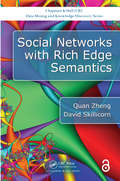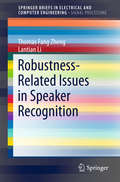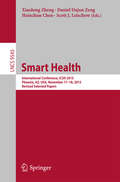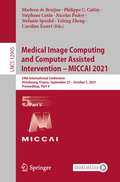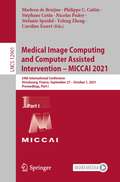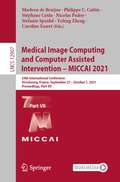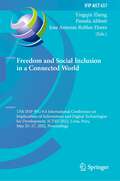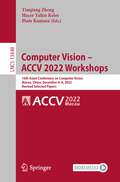- Table View
- List View
Towards Interoperable Research Infrastructures for Environmental and Earth Sciences: A Reference Model Guided Approach for Common Challenges (Lecture Notes in Computer Science #12003)
by Zhiming Zhao Margareta HellströmThis open access book summarises the latest developments on data management in the EU H2020 ENVRIplus project, which brought together more than 20 environmental and Earth science research infrastructures into a single community. It provides readers with a systematic overview of the common challenges faced by research infrastructures and how a ‘reference model guided’ engineering approach can be used to achieve greater interoperability among such infrastructures in the environmental and earth sciences. The 20 contributions in this book are structured in 5 parts on the design, development, deployment, operation and use of research infrastructures. Part one provides an overview of the state of the art of research infrastructure and relevant e-Infrastructure technologies, part two discusses the reference model guided engineering approach, the third part presents the software and tools developed for common data management challenges, the fourth part demonstrates the software via several use cases, and the last part discusses the sustainability and future directions.
Feature Engineering for Machine Learning: Principles and Techniques for Data Scientists
by Alice Zheng Amanda CasariFeature engineering is a crucial step in the machine-learning pipeline, yet this topic is rarely examined on its own. With this practical book, you’ll learn techniques for extracting and transforming features—the numeric representations of raw data—into formats for machine-learning models. Each chapter guides you through a single data problem, such as how to represent text or image data. Together, these examples illustrate the main principles of feature engineering.Rather than simply teach these principles, authors Alice Zheng and Amanda Casari focus on practical application with exercises throughout the book. The closing chapter brings everything together by tackling a real-world, structured dataset with several feature-engineering techniques. Python packages including numpy, Pandas, Scikit-learn, and Matplotlib are used in code examples.You’ll examine:Feature engineering for numeric data: filtering, binning, scaling, log transforms, and power transformsNatural text techniques: bag-of-words, n-grams, and phrase detectionFrequency-based filtering and feature scaling for eliminating uninformative featuresEncoding techniques of categorical variables, including feature hashing and bin-countingModel-based feature engineering with principal component analysisThe concept of model stacking, using k-means as a featurization techniqueImage feature extraction with manual and deep-learning techniques
Data Driven Approaches on Medical Imaging
by Bin Zheng Stefan Andrei Md Kamruzzaman Sarker Kishor Datta GuptaThis book deals with the recent advancements in computer vision techniques such as active learning, few-shot learning, zero shot learning, explainable and interpretable ML, online learning, AutoML etc. and their applications in medical domain. Moreover, the key challenges which affect the design, development, and performance of medical imaging systems are addressed. In addition, the state-of-the-art medical imaging methodologies for efficient, interpretable, explainable, and practical implementation of computer imaging techniques are discussed. At present, there are no textbook resources that address the medical imaging technologies. There are ongoing and novel research outcomes which would be useful for the development of novel medical imaging technologies/processes/equipment which can improve the current state of the art.The book particularly focuses on the use of data driven new technologies on medical imaging vision such as Active learning, Online learning, few shot learning, AutoML, segmentation etc.
Ethereum Smart Contract Development in Solidity
by Gavin Zheng Longxiang Gao Liqun Huang Jian GuanThe general consensus is that BlockChain is the next disruptive technology, and Ethereum is the flagship product of BlockChain 2.0. However, coding and implementing business logic in a decentralized and transparent environment is fundamentally different from traditional programming and is emerging as a major challenge for developers.This book introduces readers to the Solidity language from scratch, together with case studies and examples. It also covers advanced topics and explains the working mechanism of smart contracts in depth. Further, it includes relevant examples that shed new light on the forefront of Solidity programming. In short, it equips readers with essential practical skills, allowing them to quickly catch up and start using Solidity programming.To gain the most from the book, readers should have already learned at least one object-oriented programming language
Computational Methods and Clinical Applications for Spine Imaging: 5th International Workshop and Challenge, CSI 2018, Held in Conjunction with MICCAI 2018, Granada, Spain, September 16, 2018, Revised Selected Papers (Lecture Notes in Computer Science #11397)
by Guoyan Zheng Daniel Belavy Yunliang Cai Shuo LiThis book constitutes the refereed proceedings of the 5th International Workshop and Challenge on Computational Methods and Clinical Applications for Spine Imaging, CSI 2018, held in conjunction with MICCAI 2018, in Granada, Spain, in September 2018. The 8 full papers presented together with 8 short papers and 1 keynote were carefully reviewed and selected for inclusion in this volume. Papers on novel methodology and clinical research, and also papers which demonstrate the performance of methods on the provided challenges, the aim is to cover both theoretical and very practical aspects of computerized spinal imaging.
Computational Methods and Clinical Applications for Spine Imaging: 6th International Workshop and Challenge, CSI 2019, Shenzhen, China, October 17, 2019, Proceedings (Lecture Notes in Computer Science #11963)
by Guoyan Zheng Shuo Li Yunliang Cai Liansheng Wang Michel AudetteThis book constitutes the proceedings of the 7th International Workshop and Challenge on Computational Methods and Clinical Applications for Spine Imaging, CSI 2019, which was held in conjunction with MICCAI on October 17, 2019, in Shenzhen, China. All submissions were accepted for publication; the book contains 5 peer-reviewed regular papers, covering topics of vertrebra detection, spine segmentation and image-based diagnosis, and 9 challenge papers, investigating (semi-)automatic spinal curvature estimation algorithms and providing a standard evaluation framework with a set of x-ray images.
Variant Construction from Theoretical Foundation to Applications
by Jeffrey ZhengThis open access book presents theoretical framework and sample applications of variant construction. The first part includes the components variant logic, variant measurements, and variant maps, while the second part covers sample applications such as variation with functions, variant stream ciphers, quantum interference, classical/quantum random sequences, whole DNA sequences, and multiple-valued pulse sequences. Addressing topics ranging from logic and measuring foundation to typical applications and including various illustrated maps, it is a valuable guide for theoretical researchers in discrete mathematics; computing-, quantum- and communication scientists; big data engineers; as well as graduate and upper undergraduate students.
Online Resolution of E-commerce Disputes: Perspectives from the European Union, the UK, and China
by Jie ZhengThis book discusses how technological innovations have affected the resolution of disputes arising from electronic commerce in the European Union, UK and China. Online dispute resolution (ODR) is a form of alternative dispute resolution in which information technology is used to establish a process that is more effective and conducive to resolving the specific types of dispute for which it was created. This book focuses on out-of-court ODR and the resolution of disputes in the field of electronic commerce. It explores the potential of ODR in this specific e-commerce context and investigates whether the current use of ODR is in line with the principles of access to justice and procedural fairness. Moreover, it examines the major concerns surrounding the development of ODR, e.g. the extent to which electronic ADR agreements are recognized by national courts in cross-border e-commerce transactions, how procedural justice is ensured in ODR proceedings, and whether ODR outcomes can be effectively enforced. To this end, the book assesses the current and potential role of ODR in resolving e-commerce disputes, identifies the legal framework for and legal barriers to the development of ODR, and makes recommendations as to the direction in which practice and the current legal framework should evolve. In closing, the book draws on the latest legislation in the field of e-commerce law and dispute resolution in order to make recommendations for future ODR design, such as the EU Platform-to-Business Regulation on Promoting Fairness and Transparency for Business Users of Online Intermediation Services (2019) and the United Nations Convention on International Settlement Agreements Resulting from Mediation (2018), which provide the legal basis for ODR’s future development.
Ad Hoc Networks: 11th EAI International Conference, ADHOCNETS 2019, Queenstown, New Zealand, November 18–21, 2019, Proceedings (Lecture Notes of the Institute for Computer Sciences, Social Informatics and Telecommunications Engineering #306)
by Jun Zheng Cheng Li Peter Han Joo Chong Weixiao Meng Feng YanThis book constitutes the refereed proceedings of the 11th International Conference on Ad Hoc Networks, ADHOCNETS 2019, held in Queenstown, New Zealand, in November 2019. The 28 full papers were selected from 64 submissions and cover a variety of network paradigms including mobile ad hoc networks, sensor networks, vehicular networks, underwater networks, airborne networks, underground networks, personal area networks, device-to-device (D2D) communications in 5G cellular networks, and home networks. The papers present a wide range of applications in civilian, commercial, and military areas.
Ad Hoc Networks: 10th EAI International Conference, ADHOCNETS 2018, Cairns, Australia, September 20-23, 2018, Proceedings (Lecture Notes of the Institute for Computer Sciences, Social Informatics and Telecommunications Engineering #258)
by Jun Zheng Wei Xiang Pascal Lorenz Shiwen Mao Feng YanThis book constitutes the refereed proceedings of the 10th International Conference on Ad Hoc Networks, ADHOCNETS 2018, held in Cairns, Australia, in September 2018. The 27 full papers were selected from 50 submissions and cover a variety of network paradigms including mobile ad hoc networks, sensor networks, vehicular networks, underwater networks, airborne networks, underground networks, personal area networks, device-to-device (D2D) communications in 5G cellular networks, and home networks. The papers present a wide range of applications in civilian, commercial, and military areas.
Heterogeneous Vehicular Networks
by Kan Zheng Lin Zhang Wei Xiang Wenbo WangThis brief examines recent developments in the Heterogeneous Vehicular NETworks (HETVNETs), integrating cellular networks with Dedicated Short-Range Communication (DSRC) for meeting the communications requirements of the Intelligent Transport System (ITS)services. Along with a review of recent literature, a unified framework of the HetVNET is presented. The brief focuses on introducing efficient MAC mechanisms for vehicular communications, including channel access protocols, broadcast/multicast protocols, the location-based channel congestion control scheme and the content-based resource allocation scheme. The cooperative communication between vehicles is discussed. This brief concludes with a discussion on future research directions, and provides the readers with useful insights into the future designs in the HetVNETs, to motivate new ideas for performance improvements in vehicular networks.
Data-Driven Design for Computer-Supported Collaborative Learning: Design Matters (Lecture Notes in Educational Technology)
by Lanqin ZhengThis book highlights the importance of design in computer-supported collaborative learning (CSCL) by proposing data-driven design and assessment. It addresses data-driven design, which focuses on the processing of data and on improving design quality based on analysis results, in three main sections. The first section explains how to design collaborative learning activities based on data-driven design approaches, while the second shares illustrative examples of computer-supported collaborative learning activities. In turn, the third and last section demonstrates how to evaluate design quality and the fidelity of enactment based on design-centered research.The book features several examples of innovative data-driven design approaches to optimizing collaborative learning activities; highlights innovative CSCL activities in authentic learning environments; demonstrates how learning analytics can be used to optimize CSCL design; and discusses the design-centered research approach to evaluating the alignment between design and enactment in CSCL. Given its scope, it will be of interest to a broad readership including researchers, educators, practitioners, and students in the field of collaborative learning, as well as the rapidly growing community of people who are interested in optimizing learning performance with CSCL.
Knowledge Building and Regulation in Computer-Supported Collaborative Learning
by Lanqin ZhengThis book proposes and validates an information flow approach to analyzing knowledge co-construction and predicting group performance in the context of collaborative learning. In addition, it highlights the importance of socially shared regulation in collaborative learning, and illustrates in detail how it can be analyzed and promoted. The book investigates several innovative examples, including: Methodological approaches to studying and analyzing knowledge building and regulation in collaborative learning; Social software tools for capturing the dynamics of knowledge building and regulation in collaborative learning; Collective regulatory mechanisms to scaffold socially shared regulation in real-life collaborative learning; and Scripts and interventions to facilitate effective and productive collaborative learning on the basis of several case studies. The original methodological contributions to the analysis of knowledge building and scaffolding socially shared regulation make this an essential read for anyone interested in collaborative learning. This book will also be of interest to a wide audience of researchers, teachers, and students in the field of collaborative learning, as well as the rapidly growing community of people investigating how collaborative learning can be effectively used in education.
Spatially Explicit Hyperparameter Optimization for Neural Networks
by Minrui ZhengNeural networks as the commonly used machine learning algorithms, such as artificial neural networks (ANNs) and convolutional neural networks (CNNs), have been extensively used in the GIScience domain to explore the nonlinear and complex geographic phenomena. However, there are a few studies that investigate the parameter settings of neural networks in GIScience. Moreover, the model performance of neural networks often depends on the parameter setting for a given dataset. Meanwhile, adjusting the parameter configuration of neural networks will increase the overall running time. Therefore, an automated approach is necessary for addressing these limitations in current studies. This book proposes an automated spatially explicit hyperparameter optimization approach to identify optimal or near-optimal parameter settings for neural networks in the GIScience field. Also, the approach improves the computing performance at both model and computing levels. This book is written for researchers of the GIScience field as well as social science subjects.
Learning in Energy-Efficient Neuromorphic Computing: Algorithm And Architecture Co-design (Wiley - IEEE)
by Nan Zheng Pinaki MazumderExplains current co-design and co-optimization methodologies for building hardware neural networks and algorithms for machine learning applications This book focuses on how to build energy-efficient hardware for neural networks with learning capabilities—and provides co-design and co-optimization methodologies for building hardware neural networks that can learn. Presenting a complete picture from high-level algorithm to low-level implementation details, Learning in Energy-Efficient Neuromorphic Computing: Algorithm and Architecture Co-Design also covers many fundamentals and essentials in neural networks (e.g., deep learning), as well as hardware implementation of neural networks. The book begins with an overview of neural networks. It then discusses algorithms for utilizing and training rate-based artificial neural networks. Next comes an introduction to various options for executing neural networks, ranging from general-purpose processors to specialized hardware, from digital accelerator to analog accelerator. A design example on building energy-efficient accelerator for adaptive dynamic programming with neural networks is also presented. An examination of fundamental concepts and popular learning algorithms for spiking neural networks follows that, along with a look at the hardware for spiking neural networks. Then comes a chapter offering readers three design examples (two of which are based on conventional CMOS, and one on emerging nanotechnology) to implement the learning algorithm found in the previous chapter. The book concludes with an outlook on the future of neural network hardware. Includes cross-layer survey of hardware accelerators for neuromorphic algorithms Covers the co-design of architecture and algorithms with emerging devices for much-improved computing efficiency Focuses on the co-design of algorithms and hardware, which is especially critical for using emerging devices, such as traditional memristors or diffusive memristors, for neuromorphic computing Learning in Energy-Efficient Neuromorphic Computing: Algorithm and Architecture Co-Design is an ideal resource for researchers, scientists, software engineers, and hardware engineers dealing with the ever-increasing requirement on power consumption and response time. It is also excellent for teaching and training undergraduate and graduate students about the latest generation neural networks with powerful learning capabilities.
Cognitive Computing of Visual and Auditory Information (Reports of China’s Basic Research)
by Nanning ZhengThis book discusses fruitful achievements in basic cognitive theories, processing technologies of visual and auditory information and research platforms. This book also can provide strong support for the research and development of artificial intelligence of major national projects, playing important roles in national application systems such as unmanned systems and smart cities. In addition, it has laid a solid foundation for the development of artificial intelligence in China. Intended for researchers who have been following the evolution of and trends in the artificial intelligence, the book is also a valuable reference resource for practitioners and scholars at various levels and in various fields.
EAI International Conference on Technology, Innovation, Entrepreneurship and Education: TIE'2018 (Lecture Notes in Electrical Engineering #532)
by Ping Zheng Vic Callaghan David Crawford Tiina Kymäläinen Angelica Reyes-MunozThis book presents the proceedings of the 2nd EAI International Conference on Technology, Innovation, Entrepreneurship and Education (TIE' 2018), which took place at Ravensbourne University London, London, UK, on September 4, 2018. The central theme of the conference is emerging technologies in relation to business, education, social and political needs that make modern society flourish. The proceedings feature papers from a cross-disciplinary audience that explore the process of creativity and innovation. The goal is that the various disciplines can learn from each other and see how they might benefit from the cross-fertilization of practices.
Social Networks with Rich Edge Semantics (Chapman & Hall/CRC Data Mining and Knowledge Discovery Series)
by Quan Zheng David SkillicornSocial Networks with Rich Edge Semantics introduces a new mechanism for representing social networks in which pairwise relationships can be drawn from a range of realistic possibilities, including different types of relationships, different strengths in the directions of a pair, positive and negative relationships, and relationships whose intensities change with time. For each possibility, the book shows how to model the social network using spectral embedding. It also shows how to compose the techniques so that multiple edge semantics can be modeled together, and the modeling techniques are then applied to a range of datasets. Features Introduces the reader to difficulties with current social network analysis, and the need for richer representations of relationships among nodes, including accounting for intensity, direction, type, positive/negative, and changing intensities over time Presents a novel mechanism to allow social networks with qualitatively different kinds of relationships to be described and analyzed Includes extensions to the important technique of spectral embedding, shows that they are mathematically well motivated and proves that their results are appropriate Shows how to exploit embeddings to understand structures within social networks, including subgroups, positional significance, link or edge prediction, consistency of role in different contexts, and net flow of properties through a node Illustrates the use of the approach for real-world problems for online social networks, criminal and drug smuggling networks, and networks where the nodes are themselves groups Suitable for researchers and students in social network research, data science, statistical learning, and related areas, this book will help to provide a deeper understanding of real-world social networks.
Robustness-Related Issues in Speaker Recognition
by Thomas Fang Zheng Lantian LiThis book presents an overview of speaker recognition technologies with an emphasis on dealing with robustness issues. Firstly, the book gives an overview of speaker recognition, such as the basic system framework, categories under different criteria, performance evaluation and its development history. Secondly, with regard to robustness issues, the book presents three categories, including environment-related issues, speaker-related issues and application-oriented issues. For each category, the book describes the current hot topics, existing technologies, and potential research focuses in the future. The book is a useful reference book and self-learning guide for early researchers working in the field of robust speech recognition.
Smart Health
by Xiaolong Zheng Daniel Dajun Zeng Hsinchun Chen Scott J. LeischowThis book constitutes the thoroughly refereedpost-conference proceedings of the International Conference for Smart Health,ICSH 2015, held in Phoenix, AZ, USA, in November 2015. The 33 papers presented together were carefully reviewedand selected from 43 submissions. The conference focused on topics and issuesincluding medical monitoring and information extraction, clinical and medicaldata mining, health data analysis and management, big data and smart health,and healthcare intelligent systems and clinical practice.
Medical Image Computing and Computer Assisted Intervention – MICCAI 2021: 24th International Conference, Strasbourg, France, September 27 – October 1, 2021, Proceedings, Part V (Lecture Notes in Computer Science #12905)
by Yefeng Zheng Stéphane Cotin Caroline Essert Stefanie Speidel Philippe C. Cattin Marleen De Bruijne Nicolas PadoyThe eight-volume set LNCS 12901, 12902, 12903, 12904, 12905, 12906, 12907, and 12908 constitutes the refereed proceedings of the 24th International Conference on Medical Image Computing and Computer-Assisted Intervention, MICCAI 2021, held in Strasbourg, France, in September/October 2021.*The 542 revised full papers presented were carefully reviewed and selected from 1809 submissions in a double-blind review process. The papers are organized in the following topical sections: Part I: image segmentation Part II: machine learning - self-supervised learning; machine learning - semi-supervised learning; and machine learning - weakly supervised learning Part III: machine learning - advances in machine learning theory; machine learning - domain adaptation; machine learning - federated learning; machine learning - interpretability / explainability; and machine learning - uncertainty Part IV: image registration; image-guided interventions and surgery; surgical data science; surgical planning and simulation; surgical skill and work flow analysis; and surgical visualization and mixed, augmented and virtual reality Part V: computer aided diagnosis; integration of imaging with non-imaging biomarkers; and outcome/disease prediction Part VI: image reconstruction; clinical applications - cardiac; and clinical applications - vascular Part VII: clinical applications - abdomen; clinical applications - breast; clinical applications - dermatology; clinical applications - fetal imaging; clinical applications - lung; clinical applications - neuroimaging - brain development; clinical applications - neuroimaging - DWI and tractography; clinical applications - neuroimaging - functional brain networks; clinical applications - neuroimaging – others; and clinical applications - oncology Part VIII: clinical applications - ophthalmology; computational (integrative) pathology; modalities - microscopy; modalities - histopathology; and modalities - ultrasound*The conference was held virtually.
Medical Image Computing and Computer Assisted Intervention – MICCAI 2021: 24th International Conference, Strasbourg, France, September 27–October 1, 2021, Proceedings, Part I (Lecture Notes in Computer Science #12901)
by Yefeng Zheng Stéphane Cotin Caroline Essert Stefanie Speidel Philippe C. Cattin Marleen De Bruijne Nicolas PadoyThe eight-volume set LNCS 12901, 12902, 12903, 12904, 12905, 12906, 12907, and 12908 constitutes the refereed proceedings of the 24th International Conference on Medical Image Computing and Computer-Assisted Intervention, MICCAI 2021, held in Strasbourg, France, in September/October 2021.*The 542 revised full papers presented were carefully reviewed and selected from 1809 submissions in a double-blind review process. The papers are organized in the following topical sections: Part I: image segmentation Part II: machine learning - self-supervised learning; machine learning - semi-supervised learning; and machine learning - weakly supervised learning Part III: machine learning - advances in machine learning theory; machine learning - domain adaptation; machine learning - federated learning; machine learning - interpretability / explainability; and machine learning - uncertainty Part IV: image registration; image-guided interventions and surgery; surgical data science; surgical planning and simulation; surgical skill and work flow analysis; and surgical visualization and mixed, augmented and virtual reality Part V: computer aided diagnosis; integration of imaging with non-imaging biomarkers; and outcome/disease prediction Part VI: image reconstruction; clinical applications - cardiac; and clinical applications - vascular Part VII: clinical applications - abdomen; clinical applications - breast; clinical applications - dermatology; clinical applications - fetal imaging; clinical applications - lung; clinical applications - neuroimaging - brain development; clinical applications - neuroimaging - DWI and tractography; clinical applications - neuroimaging - functional brain networks; clinical applications - neuroimaging – others; and clinical applications - oncology Part VIII: clinical applications - ophthalmology; computational (integrative) pathology; modalities - microscopy; modalities - histopathology; and modalities - ultrasound*The conference was held virtually.
Medical Image Computing and Computer Assisted Intervention – MICCAI 2021: 24th International Conference, Strasbourg, France, September 27 – October 1, 2021, Proceedings, Part VII (Lecture Notes in Computer Science #12907)
by Yefeng Zheng Stéphane Cotin Caroline Essert Stefanie Speidel Philippe C. Cattin Marleen De Bruijne Nicolas PadoyThe eight-volume set LNCS 12901, 12902, 12903, 12904, 12905, 12906, 12907, and 12908 constitutes the refereed proceedings of the 24th International Conference on Medical Image Computing and Computer-Assisted Intervention, MICCAI 2021, held in Strasbourg, France, in September/October 2021.*The 542 revised full papers presented were carefully reviewed and selected from 1809 submissions in a double-blind review process. The papers are organized in the following topical sections: Part I: image segmentation Part II: machine learning - self-supervised learning; machine learning - semi-supervised learning; and machine learning - weakly supervised learning Part III: machine learning - advances in machine learning theory; machine learning - domain adaptation; machine learning - federated learning; machine learning - interpretability / explainability; and machine learning - uncertainty Part IV: image registration; image-guided interventions and surgery; surgical data science; surgical planning and simulation; surgical skill and work flow analysis; and surgical visualization and mixed, augmented and virtual reality Part V: computer aided diagnosis; integration of imaging with non-imaging biomarkers; and outcome/disease prediction Part VI: image reconstruction; clinical applications - cardiac; and clinical applications - vascular Part VII: clinical applications - abdomen; clinical applications - breast; clinical applications - dermatology; clinical applications - fetal imaging; clinical applications - lung; clinical applications - neuroimaging - brain development; clinical applications - neuroimaging - DWI and tractography; clinical applications - neuroimaging - functional brain networks; clinical applications - neuroimaging – others; and clinical applications - oncology Part VIII: clinical applications - ophthalmology; computational (integrative) pathology; modalities - microscopy; modalities - histopathology; and modalities - ultrasound*The conference was held virtually.
Freedom and Social Inclusion in a Connected World: 17th IFIP WG 9.4 International Conference on Implications of Information and Digital Technologies for Development, ICT4D 2022, Lima, Peru, May 25–27, 2022, Proceedings (IFIP Advances in Information and Communication Technology #657)
by Yingqin Zheng Pamela Abbott Jose Antonio Robles-FloresThis book constitutes the refereed proceedings of the 17th IFIP WG 9.4 International Conference on Social Implications of Computers in Developing Countries, ICT4D 2022, which was supposed to be held in Lima, Peru, in May 2021, but was held virtually instead due to the COVID-19 pandemic.The 40 revised full papers presented were carefully reviewed and selected from 58 submissions. The papers present a wide range of perspectives and disciplines including (but not limited to) public administration, entrepreneurship, business administration, information technology for development, information management systems, organization studies, philosophy, and management. They are organized in the following topical sections: digital platforms and gig economy; education and health; inclusion and participation; and business innovation and data privacy.
Computer Vision – ACCV 2022 Workshops: 16th Asian Conference on Computer Vision, Macao, China, December 4–8, 2022, Revised Selected Papers (Lecture Notes in Computer Science #13848)
by Yinqiang Zheng Hacer Yalim Keleş Piotr KoniuszThis book constitutes the refereed post-conference proceedings of the workshops held at the 16th Asian Conference on Computer Vision, ACCV 2022, which took place in Macao, China, in December 2022. The 25 papers included in this book were carefully reviewed and selected from 40 submissions. They have been organized in topical sections as follows: Learning with limited data for face analysis; adversarial machine learning towards advanced vision systems; computer vision for medical computing; machine learning and computing for visual semantic analysis; vision transformers theory and applications; and deep learning-based small object detection from images and videos.
